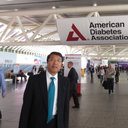Increased plasma urotensin-II levels are associated with diabetic retinopathy and carotid atherosclerosis in Type 2 diabetes.
Słowa kluczowe
Abstrakcyjny
Human U-II (urotensin-II), the most potent vasoconstrictor peptide identified to date, is associated with cardiovascular disease. A single nucleotide polymorphism (S89N) in the gene encoding U-II (UTS2) is associated with the onset of Type 2 diabetes and insulin resistance in the Japanese population. In the present study, we have demonstrated a relationship between plasma U-II levels and the progression of diabetic retinopathy and vascular complications in patients with Type 2 diabetes. Eye fundus, IMT (intima-media thickness) and plaque score in the carotid artery, BP (blood pressure), FPG (fasting plasma glucose), HbA(1c) (glycated haemoglobin), U-II, angiogenesis-stimulating factors, such as VEGF (vascular endothelial growth factor) and heregulin-beta(1), and lipid profiles were determined in 64 patients with Type 2 diabetes and 24 non-diabetic controls. FPG, HbA(1c) and VEGF levels were significantly higher in patients with Type 2 diabetes than in non-diabetic controls. Diabetes duration, insufficient glycaemic and BP control, plasma U-II levels, IMT, plaque score and nephropathy grade increased significantly across the subjects as follows: non-diabetic controls, patients with Type 2 diabetes without retinopathy (group N), patients with Type 2 diabetes with simple (background) retinopathy (group A) and patients with Type 2 diabetes with pre-proliferative and proliferative retinopathy (group B). The prevalence of obesity and smoking, age, low-density lipoprotein, triacylglycerols (triglycerides) and heregulin-beta(1) were not significantly different among the four groups. In all subjects, U-II levels were significantly positively correlated with IMT, FPG, and systolic and diastolic BP. Multiple logistic regression analysis revealed that, of the above parameters, U-II levels alone had a significantly independent association with diabetic retinopathy. In conclusion, the results of the present study provide the first evidence that increased plasma U-II levels may be associated with the progression of diabetic retinopathy and carotid atherosclerosis in patients with Type 2 diabetes.




